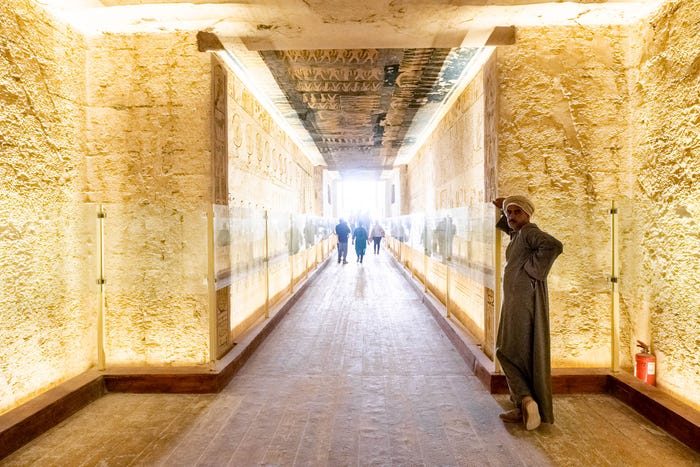Tucked beneath the sun-soaked sands of Luxor's West Bank, the Valley of the Kings is a breathtaking testament to ancient Egypt's grandeur. Renowned as the final resting place for some of Egypt’s most powerful pharaohs, this UNESCO World Heritage Site captivates travelers with its intricate tombs, vibrant wall paintings, and deep historical significance. Whether you’re an archaeology enthusiast or simply fascinated by Egypt’s ancient wonders, a visit to the Valley of the Kings is an unmissable experience.

A Royal Necropolis: Historical Background
The Valley of the Kings (Wadi al-Muluk) served as the final resting place for Egypt’s New Kingdom pharaohs, including famed rulers such as Ramses II, Seti I, and the legendary Tutankhamun. This secluded location on Luxor's West Bank was chosen for its symbolic link to the afterlife and the sun god Ra, who set in the west each evening. Over 60 tombs have been uncovered here, each telling a unique story through detailed hieroglyphs and vivid frescoes.
The Tomb of Tutankhamun (KV62): A Global Sensation
Discovered in 1922 by Howard Carter, Tutankhamun’s tomb remains the most famous in the Valley. Though modest in size, the tomb’s discovery stunned the world due to its nearly intact treasures, including the iconic golden burial mask. The Egyptian Museum in Cairo displays many of these treasures, but the tomb itself remains open for public visits, offering a glimpse into one of archaeology’s most spectacular discoveries.
Cultural Significance
Beyond being burial chambers, these tombs are sacred passages to the afterlife, reflecting the ancient Egyptians’ belief in immortality. Pharaohs were considered gods on Earth, and their tombs were designed to guide and protect them in the afterlife. The tomb walls feature scenes from the Book of the Dead, illustrating the pharaoh’s perilous journey through the underworld.
Must-See Tombs:
- Ramses VI (KV9): Known for its astronomical ceiling, this tomb offers insights into Egyptian cosmology.
- Seti I (KV17): Often regarded as the finest tomb in the Valley due to its exquisite frescoes and impressive length.
- Tutankhamun (KV62): While smaller, this tomb’s historical significance makes it a must-visit for any traveler.
Visitor Information
Location & Access
The Valley of the Kings lies on Luxor’s West Bank, easily accessible by car, taxi, or through organized tours. Luxor Booking Tours offers expertly guided visits with seamless hotel transfers.
Ticket Information
- General Entry: Includes access to three selected tombs.
- Additional Tickets: Required for entry into special tombs like Tutankhamun (KV62), Seti I (KV17), and Ramses VI (KV9).
Opening Hours:
- Daily: 6:00 AM – 5:00 PM
Pro Tip: Arrive early to avoid crowds and experience cooler temperatures.
Best Time to Visit:
- October to April is ideal due to milder temperatures.
- Early mornings provide the best lighting for photography and fewer tourists.
Unique Experiences
Explore the Iconic Tombs
- Tutankhamun’s Tomb (KV62): See where the Boy King lay hidden for centuries.
- Ramses VI (KV9): Admire the detailed astronomical ceiling, representing the night sky.
- Seti I (KV17): Discover Egypt’s longest tomb, filled with intricate wall art.
Photography Tip:
Purchase a photography pass for the chance to capture the Valley’s breathtaking interiors (note: photography is not allowed in some tombs like KV62).
Quick Facts Box
- 📍 Location: West Bank, Luxor, Egypt
- 🕒 Opening Hours: 6:00 AM – 5:00 PM
- 🏛 Top Tombs to Visit: Tutankhamun (KV62), Ramses VI (KV9), Seti I (KV17)
Conclusion
A visit to the Valley of the Kings is a step back into the golden age of Egypt, offering intimate views of the lives and beliefs of Egypt’s most powerful rulers. From the legendary tomb of Tutankhamun to the celestial ceilings of Ramses VI, every tomb unveils another chapter of Egypt’s timeless story.
Ready to Explore?
Book your Valley of the Kings experience with Luxor Booking Tours today and walk in the footsteps of Egyptian royalty!
Links & Further Reading
Author’s Note:
"As a local guide with years of experience in Luxor, I believe every visit to the Valley of the Kings reveals something new. Let Luxor Booking Tours guide you through this incredible journey—an experience you’ll never forget!"